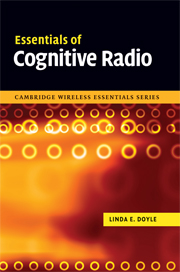Book contents
- Frontmatter
- Contents
- Acknowledgments
- List of abbreviations
- 1 A cognitive radio world
- 2 The essentials – an overview
- 3 Taking action
- 4 Observing the outside world
- 5 Making decisions
- 6 Security in cognitive radio
- 7 Cognitive radio platforms
- 8 Cognitive radio regulation and standardisation
- 9 Conclusions
- Appendix A Developments in the TV white spaces in the USA
- Index
9 - Conclusions
Published online by Cambridge University Press: 10 August 2009
- Frontmatter
- Contents
- Acknowledgments
- List of abbreviations
- 1 A cognitive radio world
- 2 The essentials – an overview
- 3 Taking action
- 4 Observing the outside world
- 5 Making decisions
- 6 Security in cognitive radio
- 7 Cognitive radio platforms
- 8 Cognitive radio regulation and standardisation
- 9 Conclusions
- Appendix A Developments in the TV white spaces in the USA
- Index
Summary
Introduction
This book has considered the essential issues associated with cognitive radio. Cognitive radio is a truly interdisciplinary topic. It crosses the fields of information theory, propagation studies, RF design, telecommunications, wireless networking, signal processing, artificial intelligence, cognitive science, software engineering, regulatory policies, security, application design, plus many many more. On the one hand the need for such a breadth of knowledge seems daunting and on the other hand it seems very exciting and opens up the way for new possibilities. In this last chapter an attempt is made to summarise the main points of the book.
A brief summing up
The first main point of the book is that a cognitive radio is not just a radio for dynamic spectrum access. The second is that dynamic spectrum access is a great idea and in looking at dynamic spectrum access many new paradigms for dynamic behaviour of radios come to light. The third point is that there are many potential applications on the horizon for cognitive radio as is hopefully clear from the simple mindmap in Figure 9.1.
Throughout the book the observe, decide and act cycle was placed at the core of the cognitive radio (Figure 9.2 recaptures the cycle). And secure, build and regulate were seen as the key additional activities of focus. Each of these topics warrants a few words.
- Type
- Chapter
- Information
- Essentials of Cognitive Radio , pp. 223 - 228Publisher: Cambridge University PressPrint publication year: 2009



